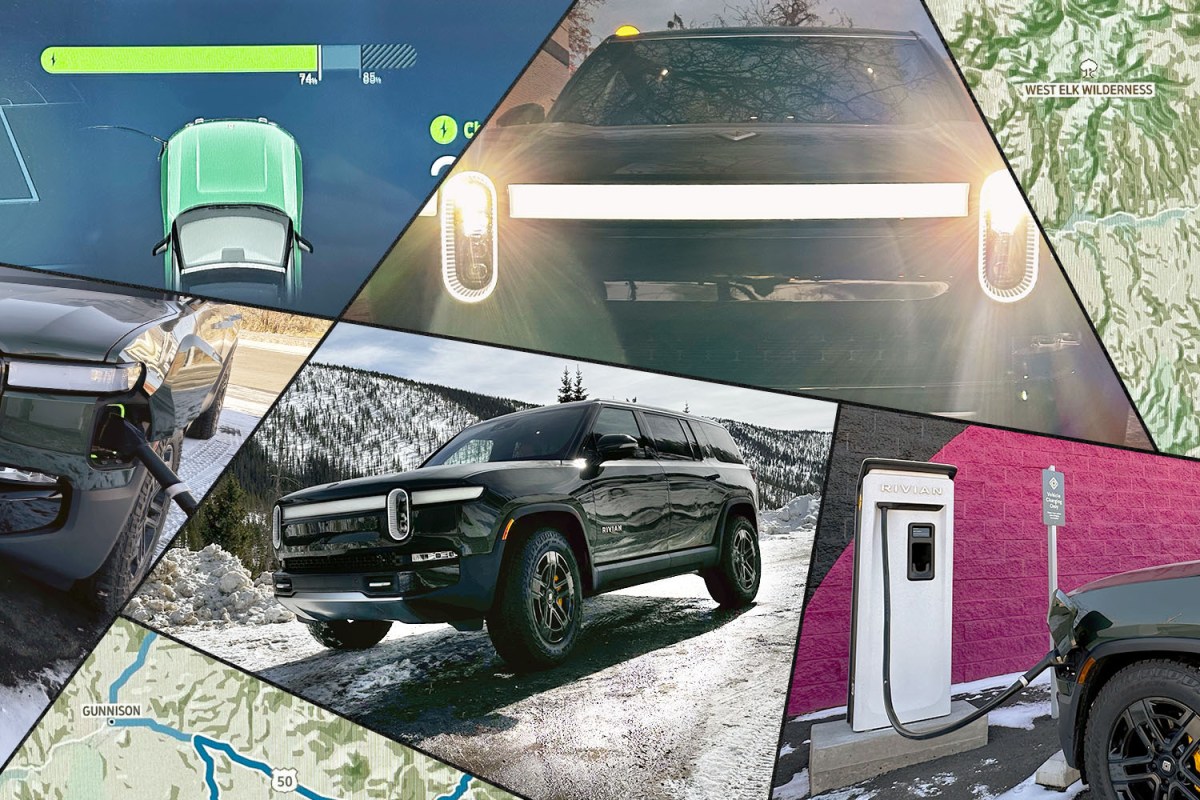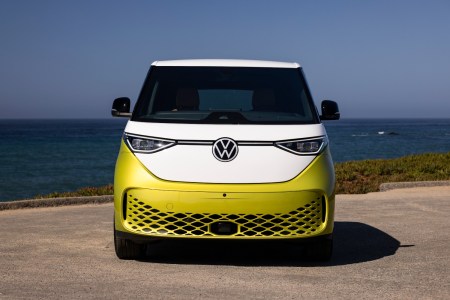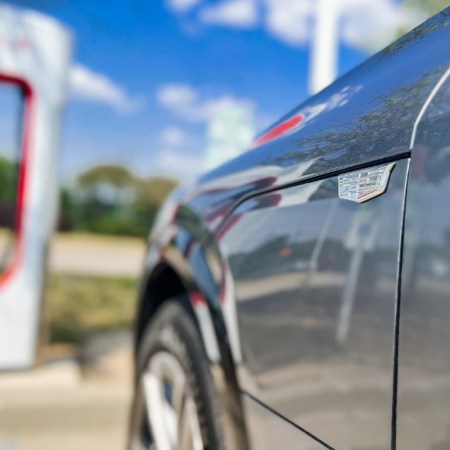My wife and I placed a reservation for a Rivian R1S in July, 2021 with a $1,000 fully-refundable deposit to hold our place in line, with the promise of taking delivery at some point in the future. At the time, Rivian was yet to deliver either the R1T, its pickup, or the R1S, the company’s SUV.
Since then, we’ve seen Rivian raise the price of both vehicles (we’re locked into the original price), with the R1S now starting at $78,000 for a dual-motor build with a standard battery pack offering 260 miles in range. In comparison, our reservation is for a quad-motor R1S with a large battery pack, offering 321 miles in range for $75,500.
Rivian first showed off a prototype of the R1S in 2018, with the first deliveries to customers starting in August 2022. Beyond the oddly shaped headlights, the overall design of the R1S looks similar to a traditional SUV, albeit with a modern design twist.
As I write this, there’s not really another all-electric SUV on the market that compares to the R1S. Tesla’s $99,990 Model X is close, also offering a 7-seat configuration, but lacks a more spacious third-row setup and storage space. Not to mention the price difference.
Other automakers such as Kia, are readying bigger all-electric SUVs, but the R1S currently lacks a true competitor in the way that a Kia Telluride has the Hyundai Palisade. Over the next year, I suspect we’ll start to see more competition with third-row SUV-style EVs.
About a month ago, we received an invite to visit Rivian’s Denver Service Center to take the R1S on a 30-minute test drive. It’s enough time to get a good feel for the vehicle, no doubt. But instead of doing that, I had already been talking to Rivian and arranged a weekend with the R1S in order to take my family on a road trip through the Colorado mountains.
I spent a total of five days with the R1S driving roughly 500 miles. There’s a lot to like about the R1S, but the real question after an extended test drive is whether or not we kept our reservation. I’m not going to spoil it. You’ll have to read on to find out.
A modern SUV
There are two screens in the front of the R1S. There’s a 12.3-inch driver display that replaces a traditional gauge cluster, showing your speed, miniature navigation and other important details. The main display that’s centered on the dashboard measures 15.3-inches and is where you find the bulk of the system controls for things like climate, driving modes, a 360-degree view when you’re backing up and media playback.
The combination of the main screen combined with the driver’s display was something I appreciated, coming from a Tesla Model 3 that lacks a dedicated screen for the driver and relies solely on the center display. Not having to look over to the side to see my current speed, or check to see if I had cruise control enabled was a small improvement over the driving experience.
The R1S is a three-row SUV that has a deceiving amount of space inside, both for passengers and gear. We packed seven people — two adults, four teenagers and a tween — comfortably inside the R1S, along with all of the luggage and snow gear for the entire group.
There isn’t a glovebox inside the R1S. Instead, there are several storage compartments throughout the interior. There are two smaller compartments on the front of the seats, handy for storing things like sunglasses or other small items. The center console’s storage space was spacious, and even had a spot for a removable Bluetooth speaker that slides in and out of the console for entertainment on the go.
The second row is adjustable, making it easy to give passengers in the third row more space when needed.
I rode in the third row for a short trip, and found it to have plenty of space for an adult with some adjustments to the second row. I wouldn’t want to ride back there for a cross country road trip, but shorter road trips wouldn’t be an issue.
The frunk — or the storage compartment where a traditional car’s engine would normally be found — was big enough to fit all of our snow gear, plus a couple duffle bags.
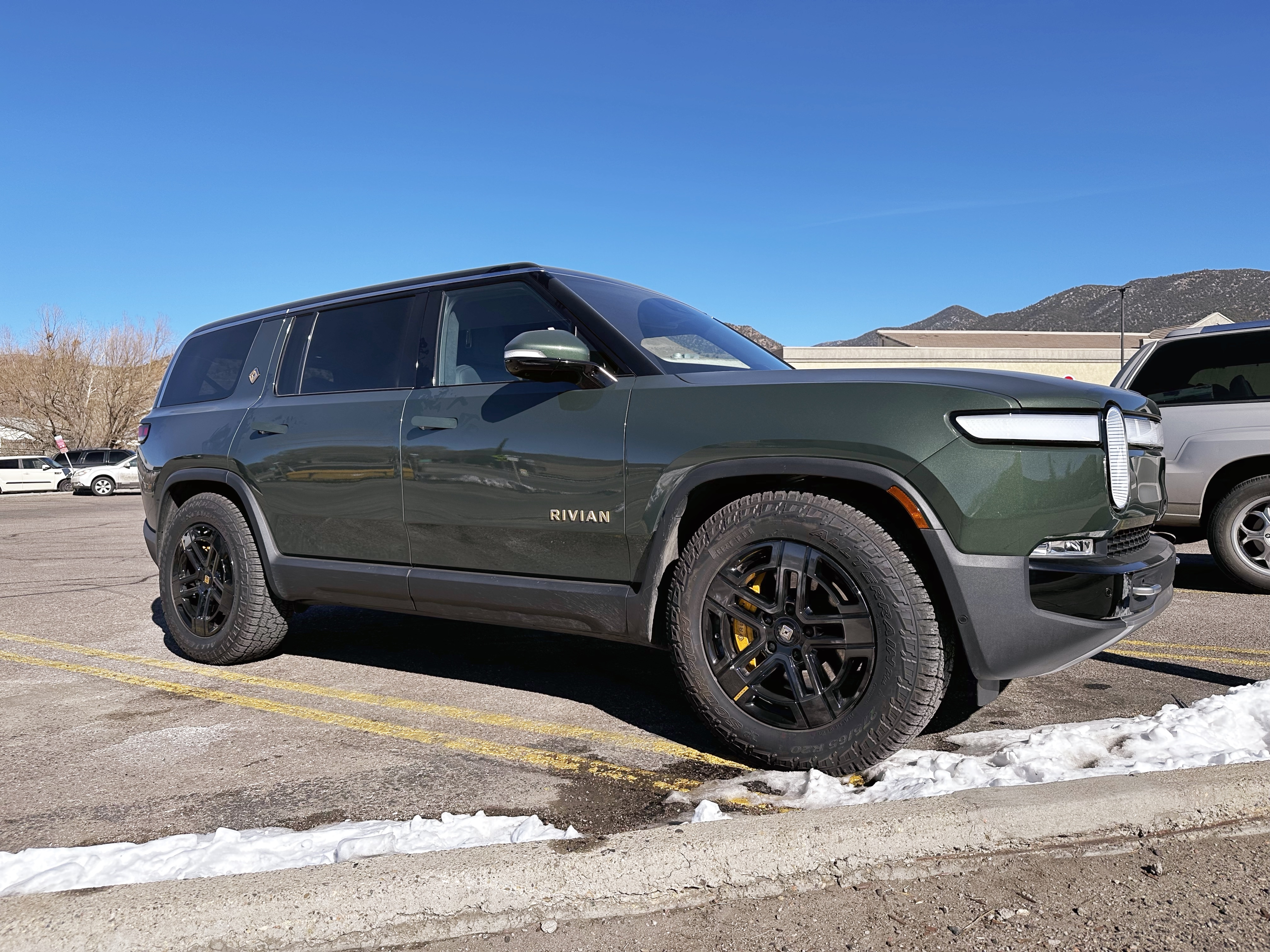
The back storage area is akin to what I’m used to in our Kia Telluride when the third-row seats are folded up. However, there’s an extra storage compartment where the spare tire normally is housed. Yes, that means the R1S doesn’t come with a spare tire; a trait that’s common with EVs. You can purchase a spare tire from Rivian when placing your order.
The exterior of the R1S contains an impressive list of tech that’s used for the company’s Driver+ suite of features. (Note the name — Driver+ — isn’t anything like Tesla’s Autopilot or Full Self Driving. Even though Rivian offers some level of driver assist features, it’s designed and named to be something that aids the driver, not replaces it.)
There are a total of 9 cameras on the exterior of the R1S, and a single camera inside the cabin to monitor the driver. Also on the exterior of the R1S are five different radar sensors and 12 ultrasonic sensors.
My personal favorite design feature of the R1S is the light bar and the headlights. They just look cool, especially when you first start charging the R1S and it lights up green to let you know charging has started.
Overall, we found the R1S to offer plenty of space for seven people, our luggage and some extra gear. It’s comfy to ride in, regardless of where you’re sitting.
Driving, range and charging experience
I’m going to say this right away: There’s no way a car this big should be this fast. If you’ve ever driven an EV before, you know what I’m talking about. There’s instant power the moment you press the accelerator that pushes you back into your seat. It’s addicting.
But it’s also something I expect from a car, not an SUV with three rows. And yet, the feeling of flooring it in the R1S felt exactly like it does in a Tesla Model 3. More specifically, it goes from 0–60 in as little as three seconds. Three seconds! That’s thanks to the quad motor setup with a max of 835 horsepower.
Impressive specs and impressive acceleration aside, I thoroughly enjoyed driving the R1S. It handled mountain road curves with ease, and had plenty of power when I needed it to pass slower vehicles on a two-lane highway. Although, I did have to turn off the Driver+ lane assist feature. I found it to be a little too aggressive with keeping me in my lane.
Can VW and Rivian's Partnership Help Them Weather the EV Storm?
There’s a lot of uncertainty on the horizonFrom my home in Pueblo to the Rivian Adventure Network (RAN) charger in Salida it’s 103 miles. The R1S’s software told me I’d go from 84% battery to 41% or 131 miles of range left after the two hour trek. And it practically nailed it. I actually arrived at the RAN charger with 137 miles of range left, which is equal to 41% charge.
We had enough charge to continue our trip to our final destination, but wouldn’t have enough range to reach Monarch Ski resort atop Monarch mountain the following day. So, I set the charge level of the R1S to 80%, plugged it in and walked across the street and had some lunch.
For the first year of ownership, Rivian owners can use any of the RAN chargers free of charge. They’re currently capable of charging at speeds of up to 200kWh. For comparison, Tesla’s SuperCharger network currently maxes out at 250kWh.
The RAN station in Salida is located next to a grocery store, and a couple of blocks walk away from the downtown area, which is full of shops, cafes and restaurants.
It took twenty-six minutes for the R1S to go from 41% to the programmed 80% cap — more than enough time to eat and do some grocery shopping, something we’d planned to do anyways. In other words, charging wasn’t an extra stop or something we had to plan around. It simply was something we did while we checked off our todo list for the weekend trip.
For the next three days, we drove to and from various mountain towns, to the top of a mountain, did it all again, all without having to charge again, at temperatures that stayed below or just above freezing. All told, we went from 80% down to 15% during our weekend-long treks.
We stopped by the RAN charger one last time before driving 103 miles back home. I plugged the R1S into the RAN charger, left the charging limit to 80% and walked away. I spent the next hour or so walking around downtown Salida, visiting local shops — yet another activity on our checklist of completing that weekend.
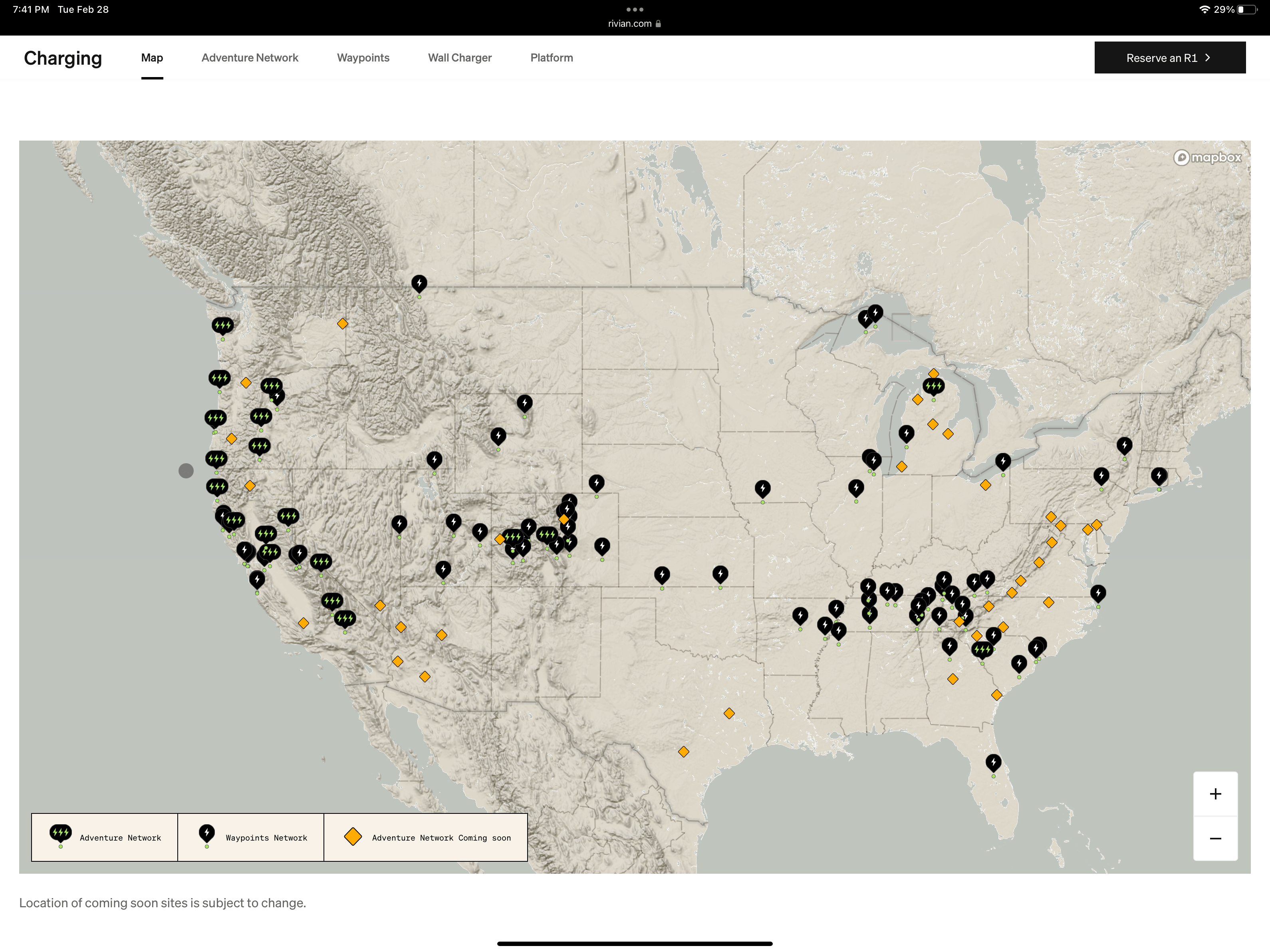
The caveat to my charging experience here is that we went somewhere with a Rivian charger. The Rivian-owned charging network is still in its infancy, and there’s a lot of work to be done. If you were to rely solely on the RAN, you’re not going to get very far right now. In the screenshot above, the fast RAN chargers are indicated by three green lightning bolts. As you can see, in Colorado, there are two, with the next closest charger found in California. The Waypoint chargers, indicated by the single white lightning bolt, are Rivian chargers, but they’re slower (charging at 11.5kWh) and aren’t designed to be used on long road trips; think of them more like convenient, passive charging while you’re eating a quick meal or while you’re on a hike (as most of them are placed in an outdoorsy area).
Third-party charging networks like ChargePoint and Electrify America can help fill in the gaps, and are even integrated directly into Rivian’s map and routing software. But my personal experience with those chargers has been hit or miss.
The recent news of Tesla opening its SuperCharger network to non-Tesla EVs by retrofitting the charging stalls with a CCS adapter for vehicles like the Rivian R1S may just be enough to give me confidence to take the R1S on a long road trip, using a combination of Tesla, EA and ChargePoint chargers to fill in the gaps in the Rivian Adventure Network.
It’s all about the software
Arguably the most important aspect of the EV experience is the software. It’s what guides you on a given route, music and entertainment, controls your comfort and gives access to various settings and preferences to ensure a smooth ride.
I like to view electric vehicles like a giant, mobile computer. Actually, scratch that. They’re like a giant smartphone…with wheels. And just like when Apple releases an iPhone update that adds new features and fixes bugs, Rivian’s R1 fleet has that same exact capability. Better yet? Rivian isn’t charging you for the updates and the added features.
My experience of owning a Tesla Model 3 since mid-2019 have shaped my expectations of what any electric vehicle should have, let alone a Rivian.
And nearly every gripe or complaint I have about the R1S is software related. For instance, there aren’t any apps or services like Netflix or YouTube currently available to entertain my family and I while we charge. The maps and navigation features lack the ability to show you a round-trip range estimate, a huge quality of life feature that eases range anxiety at the start of a trip.
On a couple of occasions, maps would present a route that made zero sense — at one point trying to get me to take a nearly four hour drive to get to a location that was 30 minutes away.
After my time with the R1S, I talked with the senior vice president of software development at Rivian, Wassym Bensaid, about the software that powers the R1 lineup. My takeaway after the call? Rivian is acutely aware of the areas where the R1’s software experience can and should be improved, and updates with new features and enhancements are coming.
That’s the magical part of owning a car such as a Tesla or a Rivian where routine software updates are a key part of the ownership experience. As Bensaid told me, “[Rivian’s] goal is to create a different connection with our customers. Our philosophy is that the act of purchasing a vehicle from Rivian, it’s not the end. It’s not just a transaction. It’s really the beginning of a journey between us and the customer.”
That journey includes monthly software updates that bring new features and capabilities to your vehicle. For instance, Rivian recently rolled out an update that increased the range on both the R1T and R1S through various optimizations. Another recent update added Kneel mode that automatically lowers the R1 when it’s put in park, making it easier to get in and out of the vehicle. Another recent update added a dedicated snow mode for winter conditions.
There’s a long list features current and potential Rivian owners want added, one of which is the ability to use the vehicles cameras to record drives, similar to how they’re used for the Gear Guide, but while you’re on the road. Recently, Rivian CEO RJ Scaringe confirmed on Twitter that an “integrated solution” for a Rivian dash cam is coming soon.
It’s easy to yell from the mountain top (and I’m 100% guilty of this) that Rivian had a blueprint of what an EVs software experience should be like, thanks to Tesla. But the reality is, at some point Rivian had to start shipping vehicles to customers and continue to build out the software experience.
And, so far, that’s exactly what Rivian has done.
Bottom line
Now it’s time for the $75,000 question: Did we keep our reservation? There was no debate. I didn’t even have to ask my wife what she wanted to do.
Our biggest concern, outside of some of the software features which I’m confident Rivian is going to fix over the next six months or so, was the third-party charging network for extended road trips. But with Tesla’s SuperCharger network adding support for all types of EVs, our confidence level in using the R1S long distance travel has gone up significantly. Hopefully by the time we take delivery later this year, Tesla’s rollout has expanded into the Midwest.
By the end of our time with the R1S, I found myself trying to justify trading in my Model 3 for an R1T — price hike be damned — and going all in on Rivian. While I’ve mostly talked myself out of doing that, we’re eagerly awaiting an email either letting us know we’ve gained access to the R1 shop where reservation holders can view nearby inventory and take delivery earlier, or that Rivian is ready for us to finalize our purchase of the R1S. Currently, our delivery estimate is July-September of this year, and it can’t get here fast enough.
This article was featured in the InsideHook newsletter. Sign up now.
